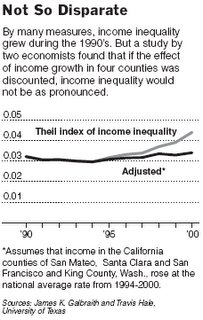Income Inequality: The Outlier Effect
 UC-Berkeley economist Hal Varian (formerly at UM) writes in the NY Times yesterday about income inequality, a topic that has received a lot of attention lately.
UC-Berkeley economist Hal Varian (formerly at UM) writes in the NY Times yesterday about income inequality, a topic that has received a lot of attention lately.The implication is that the income gains of the 1990’s associated with the technology bubble not only accrued to a relatively small number of people but also occurred in a relatively small number of geographic areas.
To drive this point home, the authors asked what would have happened to the index if just 4 of the 3,100 counties in the United States exhibited average income growth in the technology boom years. The four are Santa Clara, San Mateo, San Francisco (all associated with Silicon Valley) and King County, Wash. (home of Microsoft).
Note the remarkable difference in the Theil index (see graph above) computed with the adjusted growth rates for these four counties: If the per capita income in just these four counties had grown at the same rate as the average in the United States, income inequality across counties would have changed little in the late 1990’s. In other words, only four counties drove most of the change across the 3,100 counties.
Conclusions: a) Outliers matters and b) income inequality hasn't changed much.

0 Comments:
Post a Comment
<< Home